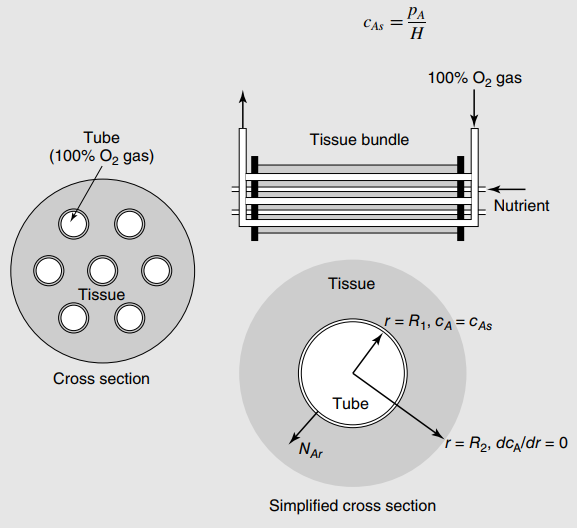Recall from example 3, Chapter 25, that the differential model for the radial concentration profile of dissolved
Question:

with boundary conditions
Often, KA is very small relative to cA so that the homogeneous reaction term approaches a zero-order process that is not dependent on concentration:

so that
where m is the metabolic respiration rate of the tissue. In the present process, in = 0.25 mole/m3 · h at 25°C, and R1 and R2 are equal to 0.25 cm and 0.75 cm, respectively. Pure O2 gas at 1.0 atm flows through the tube of length 15 cm. The mass- transfer resistance due to the thin-walled tube is neglected, and the Henry€™s law constant for dissolution of O2 in the tissue is 0.78 atm · m3/mole at 25°C. The diffusion coefficient of oxygen in water is 2.1 · 10-5 cm2/s at 25°C, which approximates the diffusivity of oxygen dissolved in the tissue.
a. Develop a model, in final integrated form, to predict the concentration profile cA(r), and then plot out the concentration profile. Note that for diffusion with zero-order homo geneous chemical reaction, there will be a critical radius, Rc, where the dissolved oxygen concentration goes to zero. Therefore, if Rc < R2, then cA (r) = 0 from r = Rc to r = R2.
b. Using this model and the process input parameter detailed above, determine Rc. Then, plot of the concentration profile from cA(r) from r = R1 to r = Rc.
c. Develop a model, in final algebraic form, to predict WA, total oxygen transfer rate through one tube. From the process input parameters given in the problem statement, calculate WA.
Figure 25.8

Step by Step Answer:

Fundamentals Of Momentum Heat And Mass Transfer
ISBN: 9781118947463
6th Edition
Authors: James Welty, Gregory L. Rorrer, David G. Foster





